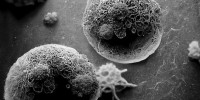
Tumor Suppressor LINC00486
Researchers investigated the role of long intergenic noncoding RNAs (lincRNAs) in Epstein-Barr virus (EBV)-driven natural killer/T-cell lymphoma (NKTCL). They identified LINC00486 as a tumor suppressor that inhibits cell proliferation and malignant transformation ability.
Nuclear factor-κB (NF-κB) plays an important role in linking persistent pathogen infection and cancer predisposition. Activation of NF-κB is involved in inflammation-related cancers, and NF-κB repressing factor (NKRF) is an alternative NF-κB inhibitor controlled by noncoding RNAs (ncRNAs). Epstein-Barr virus (EBV) is the major causative agent of lymphoid malignancies and utilizes host metabolic resources for viral replication and pathogenesis. In addition, long intergenic noncoding RNAs (lincRNAs) are involved in multiple processes as oncogenes or tumor suppressors, and they have a regulatory effect on EBV infection during tumor development. The expression, function, and clinical significance of lincRNAs in EBV-driven natural killer/T-cell lymphoma (NKTCL) are of great interest and need further investigation. And that is exactly what researchers have done in their new study:
 To explore the potential role of lincRNAs in the development of NKTCL, we performed bioinformatic prediction and experimental validation, and revealed that LINC00486 could bind with NKRF, activating p65/TNF-α signaling and transcriptionally suppressing SLC1A1.
To explore the potential role of lincRNAs in the development of NKTCL, we performed bioinformatic prediction and experimental validation, and revealed that LINC00486 could bind with NKRF, activating p65/TNF-α signaling and transcriptionally suppressing SLC1A1.
Investigating the relationship between LINC00486 and lymphoma
So what methods did the authors use? They took tumor biopsies from 537 patients with newly diagnosed lymphoma and 12 hyperplasias and subjected them to RNA sequencing and quantitative real-time PCR. RNA sequencing was performed using Hisat2 and STAR, and transcription tables were generated using the HTSeq package. Gene set enrichment analysis (GSEA) was performed using the clusterProfiler package. Real-time quantitative PCR was performed, and primer sequences are listed in Table S1. NK-92, B95-8, HEK293T, and SNK-6 cell lines were cultured under specific conditions. Cell lines overexpressing LINC00486 were constructed, and NKRF knockdown cell lines were made with four unique shRNAs. The viral supernatant was harvested and used to infect NK-92 or SNK-6 cells. The stably transfected clones were selected.
Other methods used to study the interaction between LINC00486 and NKRF: intracellular viral DNA extraction and quantification, RNA-binding protein immunoprecipitation (RIP), RNA pull-down assay, protein immunofluorescence (IF)-RNA fluorescence in situ hybridization (FISH) with double labeling (IF/FISH), and co-immunoprecipitation (Co-IP). These techniques allowed researchers to analyze the expression and localization of LINC00486 and NKRF and to determine the effect of LINC00486 on NKRF expression and function.
Tumor suppressor LINC00486's inhibitory effect on cell proliferation in NKTCL through interaction with NKRF.
In their study, the researchers identified LINC00486 as a downregulated tumor suppressor ncRNA in NKTCL, it showed its inhibitory effect on cell proliferation and malignant transformation ability. FISH and bioinformatics analyses revealed that LINC00486 is localized in the nucleus and has the potential to interact with several regulatory proteins. Further experimental verification showed that LINC00486 specifically interacted with NKRF, resulting in decreased binding capacity between NKRF and p65 and increased phosphorylation of p65, which activated cell division.
Highlights
- LINC00486 is found to be reduced in lymphoma that is positive for EBV-encoded RNA, especially in NKTCL.
- LINC00486 can inhibit the growth of tumor cells and cause them to pause in the G0/G1 phase of the cell cycle.
- LINC00486 interacts with NKRF to prevent it from binding to phosphorylated p65, which in turn activates NF-κB/TNF-α signaling and leads to improved eradication of EBV.
- NKRF specifically binds to the promoter and reduces the expression of SLC1A1 at the transcriptional level.